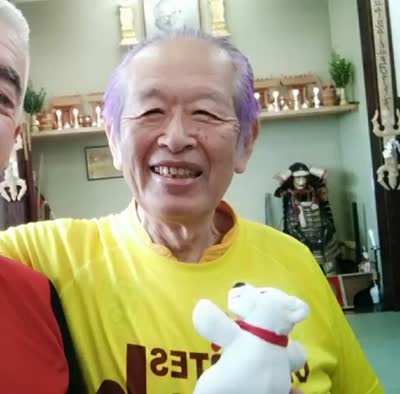KYOKETSU-SHOGE and NAGE-NAWA
From 8þ Kabutoshimen by admin
KYOKETSU-SHOGE AND NAGE-NAWA. This article is about the weapon (actually farm tool). At the end is a video (from Bujinkan Kaigozan Dojo previous week).
KYOKETSU-SHOGE
Kyoketsu-shoge (距跋渉毛) translates as “to run about in the fields and mountains”. It is one of the weapons used in Togakure-ryu and Kumogakure-ryu.
This weapon is believed to be the forerunner of Kusarigama. Wikipedia says it is a double edged blade with a curve edged blade attached. I don’t believe that was true. I think the double edged blade was just as dull as the Kunai. And only the inside of the curved blade was sharp.
The Kyoketsu-shoge was used by the rural peasantry class from the Iga province. If they was caught with something that looked too much like a weapon, they might have been executed on the spot.

I think it was a multi purpose farm tool. You dig the earth, cut the grass, tie up the grass with the rope etc. Why would a farm tool have chain. Rope made of hair was less suspicious. The farmer could stick into his belt and not cause too much attention.

NAGE-NAWA
Nage-nawa 投げ縄 (rope throwing) is not as easy as it looks. The trick is to throw the loop and make sure the rear end of the loop passes on the other side of the hand.
On the video below I show you two common techniques we in the Bujinkan Dojo use at demonstrations. In the first technique I hit down on his hands to unarm him. Threaten him with the blade and protect the sword (we had no room to do this on camera).
Throw the ring towards his head. He steps to the side and catch it. Yank it out of his grip and prepare for the throwing. Do the first loop around his hand. He grab the rope with his other hand. Make it look like a tug of war. Loop his other hand.
Blind his eyes with the rope (or Shuriken, powder etc), he covers his eyes with the hand. Continue and loop the rope around his hand and neck.
He kicks. You do Kerikaeshi and take him down. Tie him up more with the rope. Put the blade to his neck and cut his neck.
The second technique he is attacking you and you deflect withe the blade and strike with the ring behind you to hit him. Loop the sword and yank it out of his grip. Loop his hands and neck as previous technique.
Do these techniques with good choreography and acting and it will look good in demonstrations.
Yes I know looping around the sword and yanking, the sword would probably just cut the rope. Even looping around his hands he can cut the rope. These techniques is mostly for demonstrations and just fun training.
KYOKETSU-SHOGE and NAGE-NAWA at KAIGOZAN DOJO
Check out my video channel https://www.bitchute.com/bujinkan/
The post KYOKETSU-SHOGE and NAGE-NAWA appeared first on 8þ Kabutoshimen.…














 This week should have been Senō sensei’s birthday. And thinking about his classes at the honbu, it reminded me of the soft precision he used in his teachings. He was also the only Dai Shihan asking to be hit, to show the perfect timing. His Taijutsu was impressive, and he was never afraid of making mistakes. We should be doing the same.
This week should have been Senō sensei’s birthday. And thinking about his classes at the honbu, it reminded me of the soft precision he used in his teachings. He was also the only Dai Shihan asking to be hit, to show the perfect timing. His Taijutsu was impressive, and he was never afraid of making mistakes. We should be doing the same.